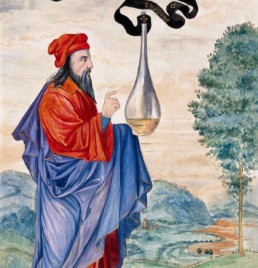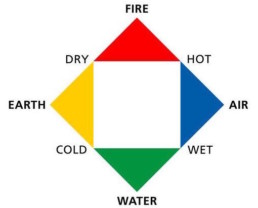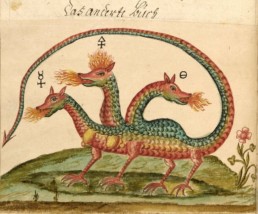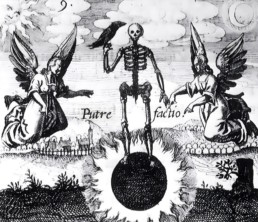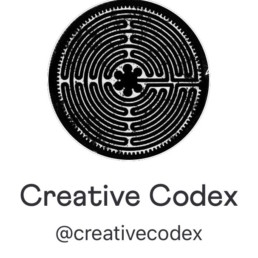RUDIMENTS of ALCHEMY
🜂🜁🜄🜃
Alchemy is an esoteric spiritual tradition whose practice centers around the manipulation and transmutation of matter. It achieves this using processes found in nature which the alchemist performs in a personal laboratory. Due to its esoteric nature, alchemical treatises and artworks are often marked by obscure references, metaphorical imagery, and a reverent spiritual tenor.
The philosophical core of alchemy is a fusion of ancient Greek philosophy, Hermeticism, and various mystical traditions from the countries in which it was first practiced—including Gnosticism, Sufism, and Kabbalah. All resulting in a rich and complicated tradition which has existed for over two thousand years—surviving wars, papal edicts, and dramatic shifts in public opinion.
The spiritual nature of the work states that: any process an alchemist performs on the matter in his/her alembic is mirrored in his/her soul. The work is thought to not only affect the physical realm, but even more importantly, both the alchemist’s and the material’s form in the subtle realm. Western Esoteric traditions define the subtle realm as ‘the place where matter becomes spirit and spirit becomes matter’.
In the following text we will explore the rudimentary concepts which are essential for any serious inquiry into alchemy.
The Four Elements
To understand alchemical theories and processes, a student of alchemy must become intimately familiar with the four classical elements: 🜂 Fire, 🜁 Air, 🜄 Water, 🜃 Earth. How they interact with one another and their respective qualities: Hot, Wet/Moist, Cold, Dry.
Each element exhibits two qualities with greatest strength: Fire is Dry & Hot, Air is Hot & Wet, Water is Wet & Cold, Earth is Cold & Dry.
Although in modern times we can argue this is a flawed understanding of the physical world, there are still benefits to viewing nature through this lens. If we try to see it the way the alchemists saw it, we notice that the four elements imbue nature’s processes with a sense of harmony and a poetic logic. Every observable process, mineral, substance, and animal in nature is connected through the interplay of the four elements.
This provides an alchemist an elegant schema for visualizing the transformations of nature:
- When the heat of fire is applied to the cold of water it transforms into wet air.
- Dry earth / leaves submerged in cold water will release some aspect of themselves when the mixture is warmed by hot fire––thereby making tea.
- A plant in earth / soil will grow when given water and fire / sunlight. Following the process of photosynthesis, the plant will release air / oxygen.
The Three Principles
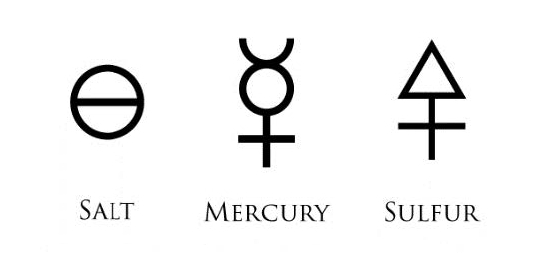 All alchemical work is supported and guided by three principles: Salt, Mercury, and Sulfur.
All alchemical work is supported and guided by three principles: Salt, Mercury, and Sulfur.
These do not exclusively refer to literal embodiments of salt, mercury, or sulphur, but rather their philosophical counterparts. In alchemical treatises you will occasionally come across passages referring to ‘philosophical mercury’ to differentiate between references to literal mercury––which is also frequently used in the work.
Where the four classical elements originated in ancient Greek philosophy, the three principles are wholly unique to the alchemical tradition. Paracelsus referred to them as the tria prima. In the book, The Hermetic and Alchemical Writings of Paracelsus, he states:
“As to the manner in which God created the world, take the following account. He originally reduced it to one body, while the elements were developing. This body He made up of three ingredients, Mercury, Sulphur, and Salt, so that these three should constitute one body. Of these three are composed all the things which are, or are produced, in the four elements.
These three have in themselves the force and the power of all perishable things. In them lie hidden the mineral, day, night, heat, cold, the stone, the fruit, and everything else, even while not yet formed.”
It is most useful to understand the three principles as multifaceted symbols, which among alchemists generally have at least three accepted meanings.
🜍 = Sulfur • Soul • Combustibility
☿ = Mercury • Spirit • Fusibility / Volatility
🜔 = Salt • Body • Non-Combustibility / Non-Volatility
Due to the inherently solitary nature of the work––and its reliance on personal revelation––some alchemists develop their own associations for these three symbols; increasing the challenges of interpretation.
“But because he carries a Rod or Caduceus about which two serpents are twined across one another, by which he can draw souls out of bodies and bring them back again and effect many such contrarities. He is a most excellent figure or representation of the Philosophical Mercury. Mercury, therefore, is Wind, which takes Sulphur, or Dionysius, or Asclepius, being yet an imperfect Embryo out of the Mother’s belly or out of the Ashes of the Mother’s body burned, and carries it thither where it may be brought to maturity.” Atalanta Fugiens, Michael Maier, 1617
The 7 Metals & 7 Planets
There are seven metals which alchemists primarily worked with: lead, tin, iron, copper, mercury, silver, and gold. One of the goals of the work of alchemy is to ‘redeem’ the base metals by turning them into the noble metals (silver or gold) through various processes of transmutation. It was believed that gold was the purest and most perfect metal, and through an extended process of purification, one could transmute a metal like lead into gold.
The alchemist’s furnace is a microcosm which mirrors the processes of nature. The prevailing theories of the time argued that the earth naturally turns imperfect metals like lead into gold over the course of centuries. Alchemists believed that by human influence, these processes could be sped up and replicated in the laboratory.
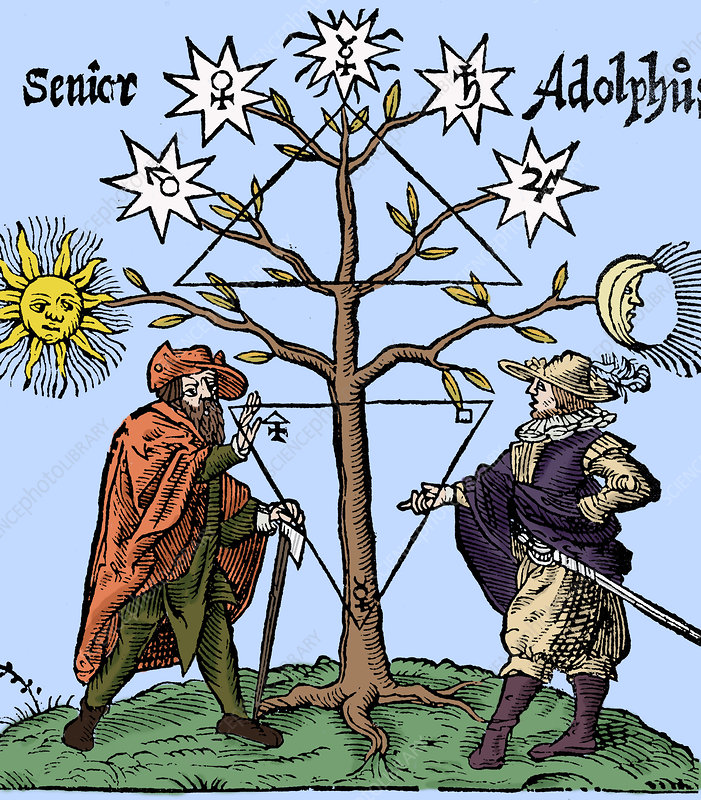
 Each of the seven metals is also paired with a celestial body––one of the seven classical planets. These are the celestial bodies which have always been visible to the naked eye in the sky: the Sun, Moon, Jupiter, Mercury, Venus, Mars, and Saturn. The metals and their respective planets have curious traits in common which explain some of their pairings.
Each of the seven metals is also paired with a celestial body––one of the seven classical planets. These are the celestial bodies which have always been visible to the naked eye in the sky: the Sun, Moon, Jupiter, Mercury, Venus, Mars, and Saturn. The metals and their respective planets have curious traits in common which explain some of their pairings.
“Belief in a linkage of these seven metals with the ‘seven planets’ reaches back into prehistory: there was no age in which silver was not associated with the Moon, nor gold with the Sun. These links defined the identities of the metals. Iron, used always for instruments of war, was associated with Mars, the soft, pliable metal copper was linked with Venus, and the chameleon metal mercury had the same name as its planet.” – Nick Kollerstrom
An alchemist must have a reliable understanding of the movements of the celestial bodies as the success of his work depends on them. If you were working with copper, you would consult with the position of Venus; and likewise with lead / Saturn, Iron / Mars, etc.
Astrology too played a part, as it often does in ancient cultures. The overall effect being that though the alchemist may pursue the Magnum Opus in secret, he sees his place in the choreography of the universe, and knows himself also to be a force therein.
“Our vessel must be such that in it matter can be influenced by the heavenly bodies. For the invisible celestial influences and the impressions of the stars are necessary to the work.” Theatrum Chemicum, Gerhard Dorn (1530-1584)
Stages & Processes
Despite the impressive length of alchemy’s history (over two thousand years) some aspects of the craft have never changed––such as the 4 stages of the work. These stages are named after the coloration of the prima materia as it undergoes transformation through various processes. The 4 stages in order are: nigredo (blackening), albedo (whitening), citrinitas (yellowing), and rubedo (reddening).
The primacy of these 4 stages can be traced as far back as the 2nd century BCE, in the writings of pseudo-Democritus. Though by the 15th century, most alchemists fused the yellowing stage into the reddening stage, resulting in only three being depicted in artworks of the time, such as in the Ripley Scroll (1450).
Concerning the stages and their respective processes, Jung wrote:
“The nigredo or blackness is the initial state, either present from the beginning as a quality of the prima materia, the chaos or massa confusa, or else produced by the separation (solutio, separation, divisio, putrefactio) of the elements. If the separated condition is assumed at the start, as sometimes happens, then a union of opposites is performed under the likeness of a union of male and female (called coniugium, matrimonium, coniunctio, coitus), followerd by the death of the product of the union (mortificatio, calcinatio, putrefactio) and a corresponding nigredo.”
“From this, the washing (ablutio, baptisma) either leads direct to the whitening (albedo), or else the soul (anima) released at the “death” is reunited with the dead body and brings about its ressurrection, or again the “many colours” (omnes colores), or “peacock’s tail” (cauda pavonis), lead to the one white colour that contains all colours. At this point the first main goal of the process is reached, namely the albedo […] highly prized by many alchemists as if it were the ultimate goal.
It is the silver or moon condition, which still has to be raised to the sun condition. The albedo is, so to speak, the day break, but not till the rubedo is it sunrise. The transition to the rubedo is formed by the citrinitas, though this, as we have said, was omitted later. The rubedo then follows direct from the albedo as the result of raising the heat of the fire to its highest intensity. The red and white are King and Queen, who may also celebrate their “chymical wedding” at this stage.”
Psychology & Alchemy, Dr. Carl Jung, 1944.
Alchemy is more than a misguided pursuit for material wealth and it’s more than just proto-chemistry. As it was practiced equally by Hermeticists, Rabbis, Sufis, Taoists, and Catholic monks, it stands as one of the most versatile and richly symbolic spiritual traditions of human culture.
With this foundational understanding of alchemy, we can better appreciate why it has survived over two millennia, while so many other traditions faded into obscurity or were effectively banned. In the words of the author, Jeffrey Raff, ‘alchemy is the tradition that refuses to die’. It continues to flow under the surface of Western culture, in the cavernous tunnels—like a river of gold—waiting to be rediscovered with each new generation.
PATREON
Become a patron of the show, and gain access to all the exclusive Creativity Tip episodes, as well as episode exclusives. Just click the button or head over to: https://www.patreon.com/mjdorian
Wanna buy me a coffee?
This show runs on Arabica beans. You can buy me my next cup or drop me a tip on the Creative Codex Venmo Page: https://venmo.com/code?user_id=3235189073379328069&created=1629912019.203193&printed=1
